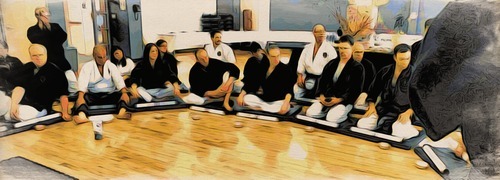
PART 2 IN A CONTINUING SERIES
I taught four hundred and twenty classes over an eighty-four day period beginning January 13, 1999. During that time, I engaged slightly over three hundred students a week.
Seventy-five percent of the nation’s professional martial arts’ community are part-time teachers. Only a very small percentage of instructors in the United States actually teach over 15 classes a week. I usually teach six, even seven days a week, 25-35 classes weekly and have done so for forty-one years, conservatively presenting over 40,000 classes. Students have traveled from the neighboring states of Connecticut, New York and Pennsylvania to study with me. One student flew in from England and another from Australia.
But I’ve never felt that it was the quantity of students that makes one a successful teacher but rather the quality and distance one’s students cover in their practice that make a successful sensei.
While the majority of our students have trained for a short time— weeks, months, or a few years, others have been allied to the Dojo teachings for decades. Regardless of their time in grade, a rare and warm comaraderie pervades the class atmosphere as we endeavor to unlock and embrace the essence of the martial arts.
The martial web is amazingly intricate. Students are connected to their many martial in-laws—fellow students. And the influence of their training touches their spouses, children, friends, associates and alliances. Each personality contributes a special perspective that catalyzes and compels the group.
Here, you will find a whole, balanced and positive system in play offering a strong counter-point to the sportification and despiritualization happening in the martial arts en masse in the U. S. today.
The history of the martial arts is not just shaped by its teachers. They only form the bow of a mighty ship moving through time. It’s the main body of practitioners who make up the core of the vessel. They bring their flow of truths and lies, insights and ignorance, expectation and reality into this evolutionary ring.
Dharman (sensei Darren) used to call me, ‘The Soul Polisher,’ from a character in the book about the Japanese swordsman, Miamoto Musashi. I published a book with that title in mind, The Soul Polisher’s Apprentice in 2007, drawing from my extensive journaling back in the early 1990’s.
On a walk in a nearby park back then, I told Dharman that I was a local instructor, a small but vital stream in the immense ocean of martial artists. Perhaps, I am a Soul Polisher to some. I certainly was to Dharman. More than likely, we are all Soul Polisher’s in our own right when we conscientiously decide to advance ourselves and/or others.
Dharman remarked that I was the very kind of stream he wanted to sit by, walk in and bring his closest friends to commune with. He felt some of the sharp edges of his person being smoothed and his life less chaotic. I knew why this was. He found himself guided into a rich interior world that enabled him to reclaim lost and vital inner territory. It was the same world that I had found.
The spiritual warrior in each of us is always seeking to liberate our fullest nature.
In my dojo, whether it be in my personal studio, or in one of the many institutions I teach at, or even in the informal ‘parking lot classes,’ where instances of spontaneous teaching occur, the students hang their politics on an invisible coat rack, remove or loosen their social masks, as best they can, and get down to the hard work of sharing their ‘Way.’
You see, the more Doh we pass around, the wealthier we all become.”
Look for future posts continuing The Chronicles Of The Doka
